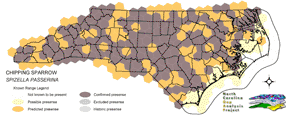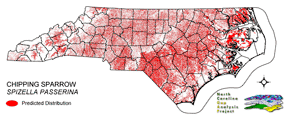
| Taxa: |
| Order: |
| Family: |
| Aves |
| Passeriformes |
| Emberizidae |
| NatureServe Global Rank: |
| NatureServe State (NC) Rank: |
| G5 |
| S5B,S5N |
| Federal Status: |
| NC State Status: |
| --- |
| --- |


| Land Unit |
| US Fish & Wildlife Service |
| US Forest Service |
| US National Park Service |
| US Department of Defense |
| NC State Parks |
| NC University System |
| NC Wildlife Res. Com. |
| NC Forest Service |
| NC Div. of Coastal Mgmt. |
| Local Governments |
| Non-Governmental Org. |
| Other Public Lands |
| Private Lands |
| GAP Status 1-2 |
| All Protected Lands |
| Statewide |
| Hectares |
| 6,929.46 |
| 11,160.99 |
| 50,485.59 |
| 1,362.96 |
| 4,164.66 |
| 1,312.38 |
| 22,777.65 |
| 2,790.09 |
| 23.49 |
| 944.46 |
| 2,395.08 |
| 2,563.56 |
| 4,144,836.60 |
| 20,081.07 |
| 105,144.57 |
| 4,251,746.97 |
| Acres |
| 17,123.07 |
| 27,579.40 |
| 124,752.59 |
| 3,367.95 |
| 10,291.10 |
| 3,242.96 |
| 56,284.79 |
| 7,139.54 |
| 58.05 |
| 2,333.81 |
| 5,918.37 |
| 6,334.69 |
| 10,242,112.30 |
| 49,866.47 |
| 260,062.92 |
| 10,506,538.60 |
| % of Dist. on |
| Prot. Lands |
| 6.6 % |
| 10.6 % |
| 47.9 % |
| 1.3 % |
| 4.0 % |
| 1.2 % |
| 20.8 % |
| 2.7 % |
| < 0.1 % |
| 2.2 % |
| 2.2 % |
| 1.8 % |
| < 0.1 % |
| 19.1 % |
| ----- |
| ----- |
| % of Dist. on |
| All Lands |
| 0.2 % |
| 0.3 % |
| 1.2 % |
| < 0.1 % |
| < 0.1 % |
| < 0.1 % |
| 0.5 % |
| < 0.1 % |
| < 0.1 % |
| < 0.1 % |
| < 0.1 % |
| < 0.1 % |
| 97.5 % |
| 0.5 % |
| ----- |
| ----- |
|
Breeds in lower elevations of the mountains (Alsop 1991), and across the piedmont (Pearson 1959). Mostly an uncommon breeder in the coastal plain, but fairly common along the North Coast section and in the southwest portion of the area (Fussell 1994). Breeds in dry (Rising and Beadle1996) areas with scattered trees, little understory (Nicholson 1997), and short, herbaceous ground cover (Alsop 1991). Can be found in diverse habitats that meet these criteria such as: back-yards (Alsop 1991), orchards, old fields (Pearson 1959), cemeteries, rural roadsides (Nicholson 1997), suburban woods, golf courses (Fussell 1994), forest edges (Potter et al 1980) mature open deciduous forests (Simpson 1992), and savannah-like oak or pine forests (Nicholson 1997). Nest is usually placed on a horizontal limb (Potter et al. 1980). Can also be in vines or on the ground (Potter et al. 1980), and is often near human habitation (Pearson 1959). Lines nest with either horse or human hair (Harrison 1975). Forages on the ground (Ehrlich et al. 1988, Nicholson 1997). NATURE SERVE GLOBAL HABITAT COMMENTS: Open woodlands, woodland edges, edges of lakes and streams, grassy fields, parks, farm yards, and orchards. BREEDING: Usually nests in trees and shrubs, usually within 1-6 m of ground but may be higher. |
| Code | Name | Description | NC Natural Heritage Program Equivalent |
| 42 | Xeric Longleaf Pine | Sandhills including a range of longleaf pine density from predominantly wiregrass, scrub oak dominated to true longleaf pine woodland. This does not include mesic or saturated flatwood types. | Xeric Sandhill Scrub, Pine/Scrub Oak Sandhill, Coastal Fringe Sandhill |
| 226 | Piedmont Xeric Woodlands | Generally post and blackjack oak dominated woodlands. White ash and pignut hickory can be found in combination with Eastern red cedar on glades. | Xeric Hardpan Forest |
| 180 | Agricultural Crop Fields | Farm fields used for row crops. | No equivalent |
| 205 | Agricultural Pasture/Hay and Natural Herbaceous | Farm fields used for pasture grass or hay production, as well as old fields dominated by native and exotic grasses. | No equivalent |
| 202 | Residential Urban | Includes vegetation interspersed in residential areas. Includes lawns, mixed species woodlots, and horticultural shrubs. Vegetation accounts for between 20 - 70% of the cover. | No equivalent |
|
Zink, R. M., and D. L. Dittmann. 1993. Population structure and gene flow in the chipping sparrow and a hypothesis for evolution in the genus SPIZELLA. Wilson Bull. 105:399-413.
Dodge, A. G., A. J. Fry, R. C. Blackwell, and R. M. Zink. 1995. Comparison of phylogenies derived from two molecular data sets in the avian genera PIPILO and SPIZELLA. Wilson Bulletin 107:641-654. Fussell, J.O. III. 1994. A birderís guide to coastal North Carolina. Chapel Hill and London: The University of North Carolina Press. Nicholson CP. 1997. Atlas of the breeding birds of Tennessee. Knoxville: University of Tennessee Press. Bureau of Land Management. Life History Summaries. Pearson, T.G. 1959. Birds of North Carolina. Raleigh, NC: Bynum Printing Company. Godfrey, W.E. 1966. The birds of Canada. National Museums of Canada. Ottawa. 428 pp. Harrison, H.H. 1975. A field guide to bird's nests in the U.S. east of the Mississippi River. Houghton Mifflin Company, Boston, Massachusetts. 257 p. Harrison, C. 1978. A field guide to the nests, eggs and nestlings of North American birds. Collins, Cleveland, Ohio. Potter, E. F., J. F. Parnell, and R. P. Teulings. 1980. Birds of the Carolinas. Univ. North Carolina Press, Chapel Hill. 408 pp. Terres, J.K. 1980. The Audubon Society encyclopedia of North American birds. Alfred A. Knopf, New York. Ehrlich, P.R., D.S. Dobkin, and D. Wheye. 1988. The birder's handbook:a field guide to the natural history of North American birds. Simon and Shuster, Inc., New York. xxx + 785 pp. Stiles, F.G., and A.F. Skutch. 1989. A guide to the birds of Costa Rica. Comstock Publ. Associates, Cornell University Press, Ithaca, New York. 511 pp. Alsop FJ III. 1991. Birds of the Smokies. Gatlinburg: Great Smoky Mountains Natural History Association. |
For more information please contact them at:
NC-GAP Analysis Project
Dept. of Zoology, NCSU
Campus Box 7617
Raleigh, NC 27695-7617
(919) 513-2853
www.basic.ncsu.edu/ncgap